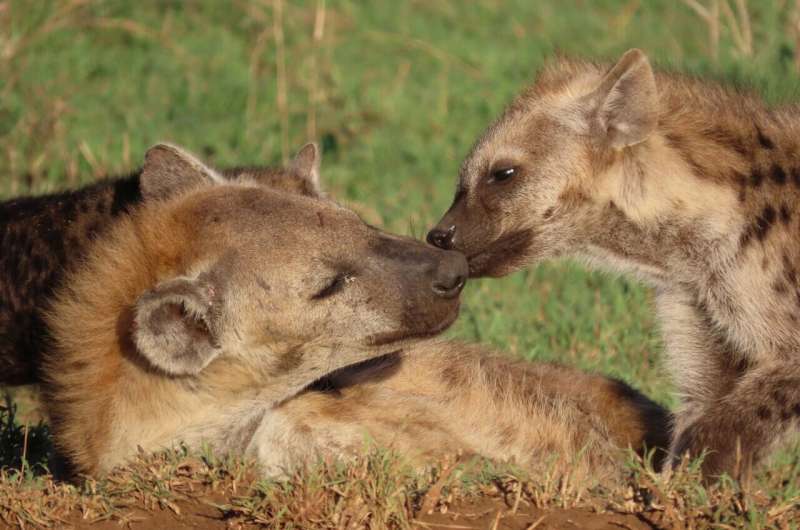This article has been reviewed according to Science X's editorial process and policies. Editors have highlighted the following attributes while ensuring the content's credibility:
fact-checked
peer-reviewed publication
proofread
When inequality is more than 'skin-deep': Social status leaves traces in the epigenome of spotted hyenas in Tanzania

In mammals, social behavior and social status can substantially influence the survival, reproductive performance, and health of individuals. However, it is not yet fully understood how the translation of social and environmental factors into the physiology of an organism is reflected in molecular processes.
Now, scientists from the Leibniz-IZW Department of Evolutionary Genetics and the Serengeti Hyena Project at the Leibniz-IZW's Department of Ecological Dynamics found that social status influenced epigenetic patterns, more specifically, the methylation of DNA in both young and adult female spotted hyenas (Crocuta crocuta) which determines the activation of genes.
They analyzed DNA from gut epithelium cells from 18 adult female hyenas and 24 cubs with known social status from three clans in the Serengeti National Park, Tanzania. The scientists identified and validated 149 genome regions where high-ranking and low-ranking individuals differed in the methylation of DNA (differentially methylated regions, DMRs).
"We could, for the first time, provide evidence for epigenetic signatures of social inequalities in both young and adult spotted hyenas," says Dr. Alexandra Weyrich, head of the working group "Wildlife Epigenetics" in the Leibniz-IZW Department of Evolutionary Genetics and senior author of the paper.
The findings show that these epigenetic signatures are stable across life stages—and that they are linked to important physiological processes: Many of the identified DMRs were involved in the regulation of energy conversion, immune response, glutamate receptor signaling, and ion transportation. "Especially the large number of DMRs in genes involved in energy conversion caught our eye," says first author Colin Vullioud, data scientist in Weyrich's working group.
Co-author Dr. Sarah Benhaiem, co-head of the Serengeti Hyena Project, explains: "We suspect that this may be driven by differences in behavior and specifically the greater use of long-distance foraging trips by low-ranking than high-ranking females—the latter monopolizing resources in their clan territory."
Interestingly, these genes were more methylated (or hypermethylated) in low-ranking adult females but not in cubs. This could indicate an adjustment of low-ranking adult females to higher energetic costs of frequent long-distance commuting, a behavior not displayed by cubs.
"Although the exact physiological consequences of the observed hypermethylation remain to be investigated, these findings are consistent with our observations and hint at the sought-after missing link between social and physiological factors," Weyrich and Benhaiem conclude.
The analyses built on the expertise in epigenetics of the Leibniz-IZW as well as on the long-term research on spotted hyenas in the Serengeti, which started in 1987. The females in this investigation are individually known, and their social status has been tracked for generations. This provided ideal conditions to study the links between behavior, physiological factors, epigenetic modifications and fitness in terms of survival and reproduction in a wild population.
"We collected our samples without invading the life of the hyenas," say Dr. Marion L. East and Professor Dr. Heribert Hofer, founders of the Serengeti hyena project and co-authors of the paper. "We followed our study animals, collected super-fresh droppings immediately after they were produced, and preserved gut epithelium samples from the surface of the feces."
The use of samples collected in a non-invasive manner is one of the strengths of the investigation, the authors surmise. "The capture methylation method we used enriches methylated DNA as well as mammalian DNA, which improved the amount of hyena DNA over bacterial DNA and the quality of the sequencing data," explains Weyrich.
DNA methylation is a chemical modification of the basic building blocks of a cell's genetic material. This modification is enabled by the transfer of methyl groups to nucleobases at certain positions in the DNA.
As the basic structure of the respective nucleobase is unaltered, DNA methylation is not a genetic mutation but a modification that determines whether this part of the DNA is 'being used' (activated) or switched off. DNA methylation is the most important epigenetic modification and, thus, a pivotal part of making genetic information available to the physiological processes within a cell.
Spotted hyenas are highly social and a model for social status-related differences in life history traits that are accompanied by differences in physiological processes and health. In hyena clans, females and their offspring socially dominate all immigrant males, and social status is behaviourally "inherited" by cubs from mothers who gain privileges associated with maternal social status.
"As in some primate species, young hyenas receive social support from their mothers during interactions with group members. From there, they learn that they can dominate all individuals who are submissive to their mother, but have to submit to those to which their mother is submissive," explains East. Therefore, social status is stable and predictable because family relationships and behavioral conventions determine it.
"Additionally, the effects of social status on life history trajectories and health are typically passed across generations," adds Hofer. For example, high-ranking females have priority access to resources in the clan territory and do not need to commute as much as low-ranking females to find food.
They are, therefore, much more often present at the communal den and more frequently nurse their young. The milk-dependent cubs disproportionally benefit at this early stage in their life—by growing faster, having a higher chance of surviving to adulthood, and starting reproduction at an earlier age than the offspring of low-ranking females.
The research is published in the journal Communications Biology.
More information: Colin Vullioud et al, Epigenetic signatures of social status in wild female spotted hyenas (Crocuta crocuta), Communications Biology (2024). DOI: 10.1038/s42003-024-05926-y. www.nature.com/articles/s42003-024-05926-y
Journal information: Communications Biology
Provided by Leibniz Institute for Zoo and Wildlife Research (IZW)




















